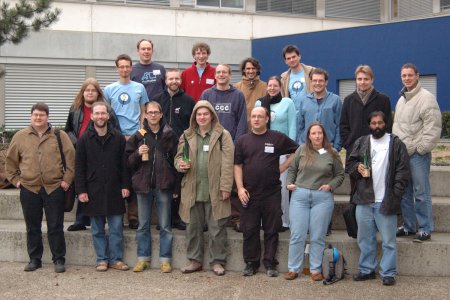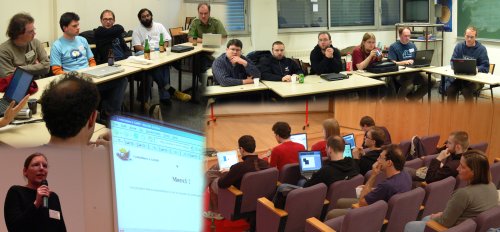GIMP Developers Conference 2006
The GIMP Developers Conference 2006 was held as a sub-event
of the

The People at GIMPCon 2006
About the GIMP Developers Conference
The GIMP Developers Conference, also known as GIMPCon, is a gathering of GIMP and GEGL developers from all over the World. It is a vital opportunity for GIMP developers to meet each other and discuss the direction which the software will take over the coming years.
There have been four GIMP Conferences previously: two in Berlin, Germany hosted by the CCC (the Chaos Computer Club), one in Kristiansand, Norway as part of GUADEC 2004 and one in Stuttgart, Germany as part of GUADEC 2005.
Minutes of the GIMP Developers Conference 2006
During LGM, we had two sessions dedicated to GIMP: one on Saturday afternoon (16:30-18:00) and one on Sunday (10:30-16:00). The following points were on the agenda:

Discussions and presentations at GIMPCon 2006
GIMP 2.4
SIOX
Gerald explained the current status of SIOX and its future developments:
- There are still some performance concerns because SIOX was designed mainly for web-sized images. In the morning, Raphaël suggested a way to add a low resolution preview for large images and this feature will be implemented soon.
- Implement a detail refinement brush. Simon suggested to apply the refinement automatically on the edge area, but Gerald replied that defining such an area assumes that the shape is simple, which is something that SIOX tries to avoid.
- New preview toggle, which temporarily disables the automatic computation for multiple brush strokes for example.
- A volunteer for integrating more SIOX features in GIMP is needed.
New tools
- Sven pointed out that the rectangular and ellipse selection tools should have the same behavior.
- The new align tool is also confusing for some users. Its behavior is still too flaky. Sven mentioned that Peter Sikking may be able to help in determining what the users want. A session with Peter is planned for tomorrow (the vision discussion).
- The code for the Lanczos interpolation is currently broken. Either we fix the Lanczos code or we hide it from the 2.4 release by removing it from the UI and from the PDB.
Google’s Summer of Code
Dave pointed out that the Summer of Code is coming soon and ideas are needed. GIMP is one of the projects which can offer tasks to be solved.
Ideas and Tasks are needed soon, probably around the beginning of May.
Preparation for the 2.4 release
Michael pointed out that some terms in the GIMP UI uses are misleading and very different from other image manipulation programs. One example is the misleading dpi instead of ppi.
Michael proposed a Texttool PDB and also new features: multiple styles for a line of text, more control over text. Unfortunately, GIMP does not currently support all pango features. Sometimes ligature problems occur with Bitstream Vera Sans.
Various other issues were also discussed: undo handling of vector operations, improvements to the full screen mode (some plug-ins cannot display progress bars), etc.
TODO
- A list of blocker bugs for the 2.4 release is needed.
- A string and UI freeze is needed.
- Mitch’s cleanup should not be commited before the 2.4 release.
- Volunteers are needed for checking GIMP terms (English and translations). A wiki page should track the terms and also possible translations. One volunteer should elaborate if Rosetta from Ubuntu can be used for this.
- A bug is needed for plug-ins which use g_message() and where dialogs pop up behind the main window.
- A volunteer is needed for the Texttool PDB.
Documentation
The manual currently features nine languages, five are activly worked on. Russian and Norwegian will be added after the 0.10 release. DocBook/XML is a barrier for new contributors, but there is currently no valuable alternative available.
For PDF creation we should use dblatex instead of the dead project db2latex.
The more translation an XML file holds the more difficult it is for contributors to concentrate on their content. Maybe we should split up the content directory-wise instead of profiling.
Michael proposed way users can comment on HTML pages like the PHP documentation. The problems are: what will happen to comments after an update of the documentation, how and who manages comments, which system will suit our needs.
TODO
- Stick to DocBook/XML for the next year. Be aware of the problems and change to a different internal structure if needed. A new project page should make it easier to contributors to join the project.
- Elaborate which issue tracker can lower the barriers for feedback from our readers without turning it into a discussion forum that needs active moderation.
GIMP 2.99
GEGL
Pippin pointed out that GEGL does not yet support calculation over regions of interest. Some of the code that does that is currently 8-bits only, but the reference buffer implementation would be 32bits float per pixel. Yosh proposed to generate all the code needed for this from a template.
Pippin: GEGL is undead.
Mitch suggested that the integration of GEGL should be in small steps. The plug-in API should be GEGL only, but will provide backwards compatibility from old plug-ins for 8bits only.
UI and Usability problems are also caused by the indexed mode. We concluded that it should be available if the user exports his image to an indexed format, like GIF or PCX. For some indexed images, the order of the colors in the palette is significant. Raphaël proposed to handle these images through GEGL as 16bits images with the 8 least significant bits representing the original palette index so that it can be restored later when saving. Gerald mentioned that Apple may already be doing something similar.
TODO
- Write the 32bits float version first, then generate others from that reference version.
- Replace the code in the base directory by GEGL operations. First replace the image map tool (used for color correction, etc.) using GEGL adapters around the pixel buffers. Then later replace the layers and masks.
How can we motivate people to join the GIMP development?
The current project page for gimp.org is not really structured and not very easy to get in touch with the developers. It would help to show to the potential contributers a list of tasks that GIMP developers consider relatively easy and useful for the next version. We could also use the task list for the Google Summer of Code or for bounties, etc.
We should make sure that people feel welcome when they read the GIMP mailing lists. For example, we should avoid criticizing those who mention GimpShop or commercial programs such as Photoshop.
Some suggestions were discussed, such as introducing aging in the list of GIMP authors. The About dialog would first list those who contributed to the current version and then a longer list of previous contributers. Sven and Yosh remarked that we are not really using the mailing lists for discussing GIMP development. Most of the discussion happens on IRC or directly between people. This could be improved. There was also some debate about how to avoid pointless discussions on the gimp-web mailing list.
TODO
- Setup a tasks list on the wiki of what can be achieved and implemented. It ranges from easy to very complex tasks. Each task should be linked to a bugzilla bug report. If someone starts working on one of these tasks, its bug report should be marked as ASSIGNED.
- Improve the infrastructure for the web site and try to make contributions easier: simpler installation and testing, if possible without requiring special skills or permissions.
GIMP vision
Peter Sikking helped us to formulate a product vision for GIMP. The vision helps to define what standard installation of the GIMP is: what plug-ins are standard and what plug-ins are optional. It shouldn’t be a simple cost-and-benefit analysis of what it means to support a feature. The current problem of the product vision is too broad to be practical. Peter proposes that our product vision should address a kind of Gauss curve of what users GIMP is made for. Currently we have the experts and newbies, but a low point for the intermediates.
Good defaults would be chosen depending on our vision, not by inventing new scenarios for each thing that we want to evaluate. The user scenarios would be written down in advance. These scenarios should not be changed afterwards because it would lead to too much discussion. The goal is to cut down all this discussion. The product vision is to be used as a filter. For example: If someone comes with the request that the UI of GIMP should be like Photoshop, we can simply state: “We are not trying to be like Photoshop, because we have a different product vision.” Though, the feature requests should still be examined carefully.
Targeted user base
GIMP targets experienced users. If we acknowledge that GIMP is not (primarily) for beginners, we cut off a lot of problems such as “do we need to support that,” etc. Peter noted that a “GIMP Light” would not just have some options cut off from the menus: it would have a completely different user interface, even if it would use the same code under the hood.
Some developers work on GIMP to promote the Free Software movement and would probably not contribute if GIMP was not free. Others think that GIMP should provide fun for its developers, although our user base has grown a bit large for just doing fun experiments. We have to acknowledge that we address a user base that may be more experienced in image manipulation than we are, so the developers are partially out of the target group.
Before converging towards a definition of the GIMP target groups and GIMP vision, there were several discussions involving examples and use cases, whether GIMP should be the best image manipulation program in the universe (best for who?), whether those working on icons and those working on photos have the same needs (number of images open, relative sizes), whether people need to switch frequently between GIMP and other applications (browser or editor for web work), whether we will support painting with shapes and natural media, etc.
Eventually, a GIMP vision emerged…
What GIMP is:
- GIMP is Free Software
- GIMP is a high-end photo manipulation application, and supports creating original art from images;
- GIMP is a high-end application for producing icons, graphical elements of web pages, and art for user interface elements;
- GIMP is a platform for programming cutting edge image processing algorithms, by scientists and artists;
- GIMP is user-configurable to automate repetitive tasks;
- GIMP is easily user-extendable, by easy installation of plug-ins.
What GIMP is not:
- GIMP is not MS Paint or Adobe Photoshop
TODO
- Make it easier to perform repetitive tasks (macro recording)
- Provide a UI with a low barrier to entry
- GIMP should be easily extensible by the average user: one click-installation of plug-ins
Minutes written by Roman Joost and Raphaël Quinet. Photos by Jean + Karine Delvare and Raphaël Quinet.